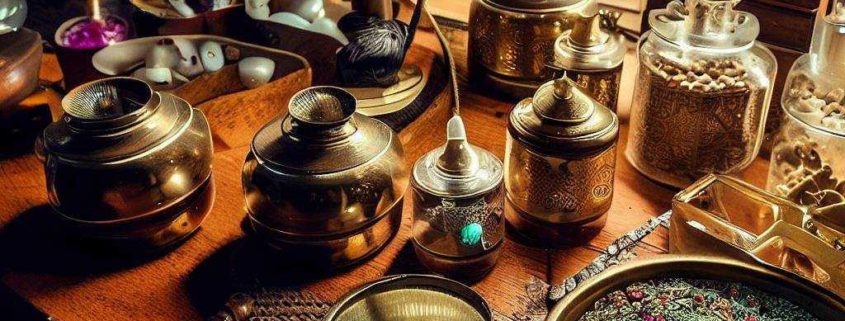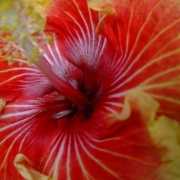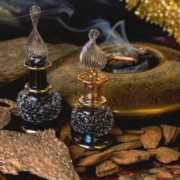Arabian Fragrances: History, Culture, and Anecdotal Chronicles
Table of Contents
-
A Journey into the Enigmatic Universe of Arabian Scents
-
Harbinger of Aromatic Complexity: the Historical Significance
-
Cultural Synthesis: The Role of Scents within Arabian Traditions
-
Essential Embellishments: Natural Constituents Defining Arabian Fragments
-
Defining Traits of Arabian Fragrances: The Essentials that Enchant
-
Tales of Enchantment: Narratives Enshrined by Fragrant Whispers
-
Timeless Fascination: the Enduring Essence of Arabian Fragrance
-
Finale of Odoriferous Expedition: a Perfumed Odyssey Through Temporal and Cultural Dimensions
A Journey into the Enigmatic Universe of Arabian Scents
When contemplations meander towards opulence, entrancing aromas, and the potent artistry of fragrances transporting us across continents, it’s inevitable that Arabian perfumes emerge as the embodiment of these notions. Enriched by roots entwined with antiquity and cultural opulence, these fragrant wonders transcend their olfactory allure. They metamorphose into vessels of chronicles chronicling age-old traditions, lavish lifestyles, and captivating tales that have withstood the tides of time.
Harbinger of Aromatic Complexity: the Historical Significance
Arabian fragrances boast a historical tapestry woven across centuries. Spreading its genesis from the heartland of the Arabian Peninsula, these scents have consistently epitomized opulence and refinement since epochs past. From the bustling trade caravans of yore to the luxurious courts of Arabian sovereigns, these olfactory wonders have etched indelible impressions.
Cultural Synthesis: The Role of Scents within Arabian Traditions
Within Arabian customs, fragrances embody a multilayered essence far exceeding mundane personal grooming. They intricately interlace with spiritual rituals, forging a sensorial bridge to the divine realm. The act of anointing with perfumes before prayer 1, referred to as “itr,” enacts a tradition weaving spiritual connections for individuals. Beyond this, these aromas grace festivities, unions, and everyday rituals, symbolizing warmth and the ethos of hospitality.
Within Arabian traditions, the significance of scents takes on an even deeper dimension through the influence of Prophet Muhammad’s traditions, known as “hadith“. These sacred teachings have seamlessly woven fragrance into the fabric of Arabian perfume culture, adding layers of spirituality and reverence to an already cherished practice.
The practice of applying perfumes, or “itr,” before prayer is not only a reflection of personal grooming but also a gesture of humility and devotion. This act finds its roots in the hadith, where Prophet Muhammad himself encouraged the use of fragrances before entering into prayer. His teachings emphasize the importance of cleanliness and pleasant scents as a means of enhancing the spiritual experience and demonstrating respect for the divine.
Ayesha reported: “The Oud was the best type of perfume the Prophet loved.”
Anas reported: “The Prophet never declined to have a touch of perfume offered to him.”
Ayesha reported: “The Prophet disliked to go out to meet his companions without wearing some perfume. He would have a touch of perfume toward the end of the night.”
The hadith holds accounts of the Prophet’s own appreciation for fine scents and his commendation for wearing them on special occasions, like on Friday, the day of the communal prayer, or, for ladies, after menstruation. This has shaped the way perfumes are perceived within Arabian culture, turning them into vessels that connect individuals not only with their heritage but also with the teachings of their faith.
Incorporating the hadith into Arabian perfume culture deepens the connection between the spiritual and the sensory. Perfumes are no longer just an adornment but a bridge between the physical and the metaphysical, a conduit to experience the divine on a more intimate level. This synthesis of religious teachings and fragrant practices reinforces the enduring role of scents within Arabian traditions, making perfumes an integral part of the cultural tapestry that continues to be woven with reverence and devotion.
Essential Embellishments: Natural Constituents Defining Arabian Fragments
Engaging in discourse regarding Arabian perfumes naturally directs us to the enchanting elements composing these olfactory spectacles. Harvested from nature’s treasury, ingredients like agarwood, rose, saffron, and ambergris coalesce into an orchestration that’s both captivating and enduring. The intricate process of extracting these aromatic facets accentuates the artisanal dedication interwoven into each perfume’s conception.
Defining Traits of Arabian Fragrances: The Essentials that Enchant
Arabian fragrances are renowned for several key characteristics that distinguish them in the world of scents. These traits, cherished for generations, are deeply embedded in the culture and heritage of the region. Among the essential components that define and enrich Arabian fragrances, a few stand out prominently:
Rich Natural Ingredients: Arabian fragrances are often celebrated for their use of natural elements. Ingredients like agarwood, known as “oud,” and rose, are beloved for their distinct aromas that capture the essence of the Arabian landscape.
Spices and Resins: The inclusion of spices like Saffron and resins like Frankincense and Myrrh imparts a warm and inviting character to these fragrances. These elements contribute to the uniqueness and depth of Arabian scents.
Ambergris: Ambergris, a rare and prized ingredient derived from the sea, lends a complex and enduring quality to Arabian fragrances. Its earthy and marine notes add a touch of luxury and sophistication.
Simplicity and Longevity: Arabian fragrances often exhibit simplicity in their compositions, focusing on a select few ingredients. This simplicity contributes to their longevity, allowing the fragrance to linger on the skin for extended periods.
Cultural Significance: Arabian fragrances hold deep cultural significance. They are intertwined with everyday life, symbolizing hospitality, spirituality, and tradition. The act of applying perfumes before prayer, for instance, is a cherished custom that reflects their cultural importance.
Earthy and Warm Notes: Arabian fragrances often feature earthy and warm notes that evoke the landscapes and environments of the region. These notes create a sense of familiarity and comfort.
Long-Lasting Impact: Arabian fragrances are known for their longevity. A small application can provide a powerful and lasting scent experience, making them a practical and preferred choice.
In summary, Arabian fragrances are characterized by the use of rich natural ingredients, spices, resins, and unique elements like ambergris. The enduring allure of Arabian fragrances lies in their ability to transport wearers to the heart of Arabian heritage, while also appealing to contemporary sensibilities.
Tales of Enchantment: Narratives Enshrined by Fragrant Whispers
Arabian fragrances aren’t merely harmonious concoctions; they embody enchanting sagas. Chronicles of merchants navigating desert landscapes laden with precious fragrance cargoes, sagas of adept perfumers crafting distinctive essences for the aristocracy, and anecdotes of poets immortalizing these scents in verse—all of these contribute to the mystique veiling Arabian perfumes.
Timeless Fascination: the Enduring Essence of Arabian Fragrance
The enduring allure of Arabian fragrances finds its roots in their capacity to transcend transient trends and eras. Their profound historical import, cultural resonance, and the entrancing tales they encapsulate elevate them beyond the realms of mere commodities. Arabian perfumes encapsulate artistry, opulence, and a sensorial gateway to the heart of Arabian heritage.
Finale of Odoriferous Expedition: a Perfumed Odyssey Through Temporal and Cultural Dimensions
Within the realm of scents, Arabian perfumes stand as paramount treasures that have enriched human lives for generations on end. Their odyssey, spanning from ancient trade routes to the present era, stands testament to the indomitable spirit of culture and the eternal allure of fragrant magic. As we inhale the intricate symphony of an Arabian perfume, we imbibe the essence of history, culture, and enchanting sagas that persist in casting their spell.
See AbdesSalaam Attar Arabian Perfumes

























Leave a Reply
Want to join the discussion?Feel free to contribute!